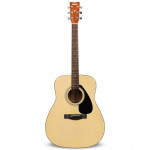Shop by Brand
Shop By Availability
Yamaha occupies a surprisingly unusual niche in the guitar industry.
The company, which is celebrating the 50th anniversary of its presence on the American market and export to other countries beyond Japan, has consistently produced guitars that have sold in impressive numbers and attracted a notable following of celebrity players and esteemed pros.
Yet the success of Yamaha guitars is influenced more by their reputation for high quality and the outstanding value their instruments offer for the money than by the usual forms of guitar hero worship that drive many guitar sales. As a result, Yamaha has quietly satisfied the needs of all walks of players from beginner to pro while an ever-changing parade of trendier instruments have hogged the spotlight.
Although Yamaha was originally founded in 1887 to produce pianos and organs, the company did not start building guitars until the early Forties, eventually opening a factory dedicated exclusively to guitar construction in Hamamatsu in the late Forties. Yamaha’s first guitars were nylon-string classical models, and these guitars were sold only by retailers within Japan through the Fifties and early Sixties.
By the mid Sixties, the entire world had a fever called Beatlemania, and the only prescription was more guitars. The United States was particularly stricken, and domestic guitar companies struggled to keep up with the increasing demand for anything with six strings. To satisfy customers, particularly those on tight middle class budgets, retailers turned to Asian manufacturers to fill their shelves with affordable, low-cost instruments.
The phenomenal increase in demand for guitars was very beneficial to Yamaha. The company already had more than two decades of experience building guitars, and the decision was made to pursue these new opportunities in a grand fashion. In 1966, Yamaha sold their first export models, which consisted of the G50, G60, G80, G100, G120 and G150 classical guitars, all produced at their Hamamatsu factory.
The models sold for retail prices ranging from $49 to $109. That same year, Yamaha established a custom shop dedicated to the production of the finest instruments they could make, and they started to collaborate with outside experts. Their first collaboration was with Spanish guitar builder Eduardo Ferrer, who helped Yamaha refine the designs of its classical guitar models. This led to the development of the GC5, GC7 and GC10 models, which made their debut in 1967.
At the same time during the mid Sixties, Yamaha expanded its production by offering its first steel-string and electric models, including bass guitars. Yamaha’s classical guitars and new steel-string line, which consisted of the dreadnought FG150 and FG180 models (also introduced in 1966 and priced at $99.50 and $119.50, respectively), sold in impressive amounts in the United States, but the company’s earliest electric guitars and basses were only distributed in Japan. Electric models included the SG2, SG3, SG5 and SG7 solidbody guitars and the SB-2 solidbody bass.
Like many other electric guitars produced in Japan during the Sixties, Yamaha’s first solidbody guitars had distinctive, radical body shapes, particularly the SG5 and SG7 with its dramatic curves, small upper bass bout horn and svelte treble cutaway horn. Even more impressive was the fact that the bridge, vibrato and pickups (which included a pair of single-coil bridge pickups in a single housing for the SG3 and SG7) were of Yamaha’s own design.




